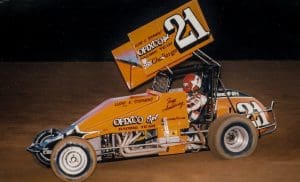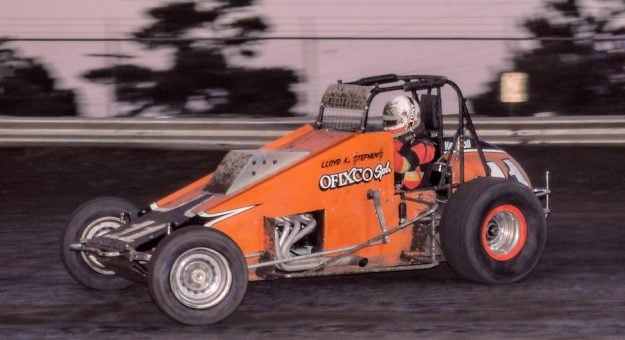TULSA, Okla. — One of the early stories from the Chili Bowl is the performance of Oklahoma driver Hank Davis. He introduced himself to the larger racing community with a preliminary night win in 2023 and added a second-place effort behind two-time USAC champion Buddy Kofoid to punch his ticket into Saturday’s 55-lap feature.
It could be the start of a big year for Davis, who will run the full USAC NOS Energy Drink Midget Series with Cornell Racing Stables. This longtime USAC team will come equipped with a new Triple X chassis powered by a Stanton Sr-11x engine.
One man who keeps a keen eye on Davis is former Oklahoma open-wheel standout Tony Armstrong. Davis is Armstrong’s great nephew. Bloodlines aside, Armstrong thinks there is a lot to like about the way Davis approaches his craft. It has an old-school feel. One also surmises that watching Hank try to claw his way forward brings back a wave of memories for Armstrong.
Armstrong’s uncle George Wilson may have been the first in his clan to give racing a whirl, but it was Armstrong’s older brother that really put the family on the racing map. George Armstrong returned from the service in 1967 and it was Wilson who first offered him a ride. By 1979, George Armstrong topped the Tulsa Speedway supermodified points, a title sandwiched between championships bagged by legendary drivers Ray Crawford and Emmett Hahn. Tony Armstrong was 19 years younger than his brother and after losing his father when he was 15 years old, he was going to have to find his own way through life.
He knew he wanted to race and did everything he could to get close to the sport. Armstrong and friend Harold Harris followed Ron Shuman and builder/owner Gary Stanton and would do anything they could do to be helpful.
A big step came when he began doing odd jobs for Firestone dealer and Tulsa racing icon John Kalb. Kalb would also hold racing seminars at his shop near the fairgrounds and Armstrong soaked all that information up like a sponge. Among a wide range of involvements, Kalb fielded a sprint car that carried No. 721 and when Ron Shuman scored a win at Florida’s East Bay Raceway in February 1979, Armstrong was there.
Hungry to race, he teamed with a local Snap-on Tools dealer named Chuck Etzkorn and decided to put a car together. Kalb kicked in with six new tires and wheels.
“We grabbed one of George’s old bent up frames out back and put it together,” Armstrong explained, “We tried to run in the six-cylinder class on the big five-eighths-mile at Tulsa and we just kept blowing up. I finally took an engine block to Steve Carbone’s shop to see if he could help.”
Carbone was a central cog in Lloyd K Stephens’ OFIXCO racing team. At the time Tulsa’s Jerry Stone was capably handling Stephens’ supermodified, but Stephens had also been toying with the idea of getting a six-cylinder team together.
Armstrong’s timing was perfect.
“Steve had the idea that he wanted to build a V-6 engine and he liked how I drove the crap out of my old car until it blew up,” Armstrong said. “So, he said that he was going to put a brand-new car together and asked if I would drive it the next year. He went and got a brand-new 100-inch Stanton car and built a state-of-the-art V-6 and we painted it white. We ran it for two weeks and Lloyd came and bought the car, the truck and the trailer, and the next week it was all orange.”
The next season I won the championship.
Armstrong became a fixture on the Oklahoma and NCRA circuits, racing 70 to 80 times per year.
Later he hit the road with the World of Outlaws and remembers that when Ted Johnson came by with a little tow money “that was like gold to us. That allowed us to get to the next place. We couldn’t call mom or dad for money or put more on a debit card.”
A big moment came in 1987 when he nailed down a USAC victory at Jackson, Minn., driving for Hall of Fame owner Stan Shoff. By 1990, he had hung up the helmet.
Armstrong did all the necessary grunt work to get close to the sport, relied on his own resources and attracted the eye of people who could get him to the places he wanted to be. He sees all of these traits in Hank Davis.
“He is just bringing his helmet along, not a check and I think because the Seymours and Cornell are old school teams, they like that.”

When he looks back to some of the obstacles Davis has navigated, he can’t help but think back to those days when he and Etzkorn cobbled a car together and did their best to go fast.
“I first realized Hank could really race when he started running POWRi midgets,” he said. “His car was underpowered and he would go fast until the thing would break. It would be a mechanical failure in the motor, or something silly in the driveline and they couldn’t replace old parts with new parts. It wasn’t a horrible car; it just wasn’t durable given how hard they ran those poor little midgets. But Hank was always putting himself in a good spot and he hardly ever crashed.”
Armstrong thinks a lot of credit goes to an old friend and fellow racer Dean Franklin.
“Dean has been a tremendous asset in developing Hank,” Armstrong said. “Of course, it is a wonder that he is still alive. Dean would have something like a hot water tank for a hood on some piece of crap race car that he would drive. I saw him crash at I-70 once and I just knew he was dead, but he would go on to the next race and live out of his van just like an old-school tough guy.”
He doesn’t think Davis will be forced to travel that hard road, but he appreciates that he earned his opportunities.
“He is just a natural little racer and a great kid.,” Armstrong said. “Just like last night he just sees the racetrack really well, especially when you think about how few laps he has really made. He was keeping up with (Buddy) Kofoid, who is a bad ass, and was setting up to pass him. For as little experience as he has, he just has the “it” factor. I just really hope he gets some good breaks. I really feel like if he gets some opportunities, he will make it.”
When Tony Armstrong pulls into the parking lot on Saturday night, he will likely take a glance over at the northeast corner of the Fairgrounds. Many summers ago, he was a young kid trying to find his racing legs, and he appreciates Hank Davis is embarking on a similar journey.
